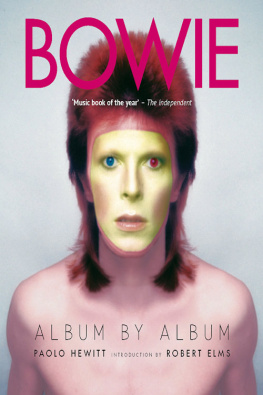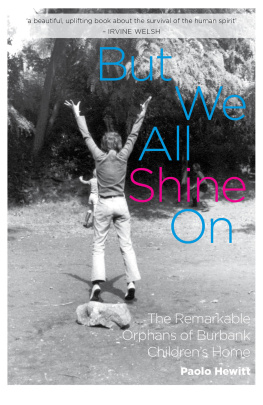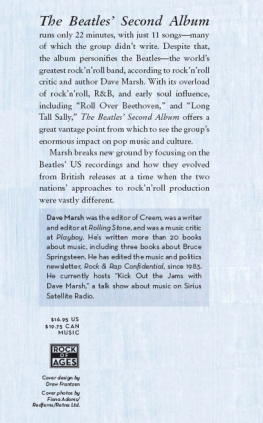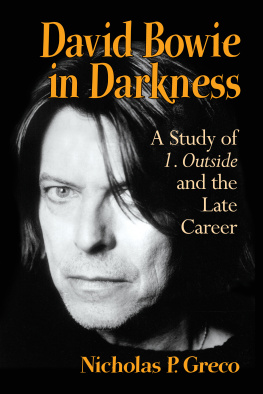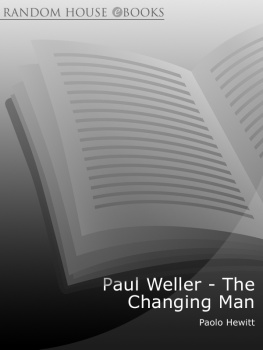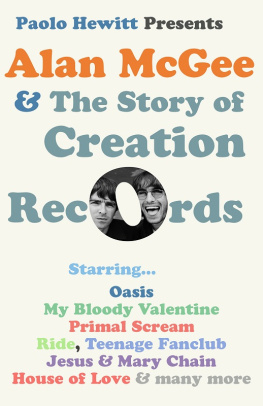Paolo Hewitt - Bowie: Album by Album
Here you can read online Paolo Hewitt - Bowie: Album by Album full text of the book (entire story) in english for free. Download pdf and epub, get meaning, cover and reviews about this ebook. year: 2016, publisher: Insight Editions, genre: Non-fiction. Description of the work, (preface) as well as reviews are available. Best literature library LitArk.com created for fans of good reading and offers a wide selection of genres:
Romance novel
Science fiction
Adventure
Detective
Science
History
Home and family
Prose
Art
Politics
Computer
Non-fiction
Religion
Business
Children
Humor
Choose a favorite category and find really read worthwhile books. Enjoy immersion in the world of imagination, feel the emotions of the characters or learn something new for yourself, make an fascinating discovery.
- Book:Bowie: Album by Album
- Author:
- Publisher:Insight Editions
- Genre:
- Year:2016
- Rating:5 / 5
- Favourites:Add to favourites
- Your mark:
- 100
- 1
- 2
- 3
- 4
- 5
Bowie: Album by Album: summary, description and annotation
We offer to read an annotation, description, summary or preface (depends on what the author of the book "Bowie: Album by Album" wrote himself). If you haven't found the necessary information about the book — write in the comments, we will try to find it.
Bowie: Album by Album — read online for free the complete book (whole text) full work
Below is the text of the book, divided by pages. System saving the place of the last page read, allows you to conveniently read the book "Bowie: Album by Album" online for free, without having to search again every time where you left off. Put a bookmark, and you can go to the page where you finished reading at any time.
Font size:
Interval:
Bookmark:

ALBUM BY ALBUM
Paolo Hewitt

EVERYBODY WAS BOWIE
From the moment he appeared on Top Of The Pops performing Starman on that fateful Thursday evening in July, 1972 skinny and skin-tight, pale and pretty, hair vivid orange and teased to the heavens, acoustic guitar slung over his back, arm draped around Mick Ronson in a gesture which took your teenage breath away everything and everybody was Bowie.
It didnt matter where you came from, if you were a skinhead or suedehead, a rocker or reggae boy, a small-town teen, surly suburban oik or an in-your-face inner-city dude, from that life-changing, epoch-making Thursday onwards you had been touched by the Starman and you stayed touched. What Elvis and his pelvis were to a generation of Americans before a catalyst and a cause clbre, a reason to rebel, perform and create so Bowie, with those alien eyes, was to kids growing up in crappy, strife-torn, early closing, corrugated-iron clad seventies Britain.
It was of no importance that David Bowie/Jones had spent the previous decade desperately trying to find his persona and his voice. Who knew or cared that this new leper messiah had a slew of former lives? Suddenly hed hit perfect pitch and for the next dozen or so years he stayed at the vanguard of just about everything good and wild that came out of Britain. There was barely a band or an artist, designer or writer, photographer or hairdresser who didnt trace their creative lineage back to Bowie and, in particular, Ziggy Stardust and The Spiders From Mars.
To understand the full potency of Bowie back then, you have to realise just how grey and broken Britain was in the early seventies. If the sixties had been a massive party this was the hangover: dreary, depressed and dominated by a suffocating corporatism that saw the country lurch from crisis to crisis while listening to leaden, long-haired rock bands in flapping flared jeans. Backward-looking, culturally conservative, prone to random violence and still fighting former wars, Britain was seen as the sick man of Europe and the prospects for a teenager growing up here were pretty bleak.
Previously, lurking beneath this grim monotone faade, there was a vibrant youth culture born of the streets vast reserves of teenage desire and creativity manifested as teddy boys and beatniks, mods and rockers, hippies and skinheads, a litany of trouser tribes with glorious soundtracks to match. But by 1972 it seemed to have run out of steam. The new decade had no real cult to call its own. What was needed was a figurehead, a charismatic leader who could rally the troops with a song and a style. Thats when the man fell to earth.
Glam rock was not a youth cult as such. Burly navvies wrapped in BacoFoil, like Sweet or Slade, were never going to provoke a generational shift and a unified movement, but the gorgeous pair of cockney chameleons Bowie and Bolan, the glitter twins, the best of buddies and the most intense of rivals hit a riff that made plenty swoon. And it was Bowie, only Bowie, who by his very presence, his elegant artifice and otherworldly air, opened the eyes of thousands of slack-jawed urban urchins to another world.
Bowie, with his coiffure and his couture, his arts labs and mime acts, bisexual hints and louche lyrics, his kabuki and Nietzsche, was like a portal to a glamorous, forbidden planet none of us even knew existed. Before David stepped out as Ziggy Stardust, fellating Mick Ronsons Les Paul while wearing Kansai Yamamoto, the average British teenager was furtively reading Razzle and wearing a donkey jacket. Afterwards the Bowie boys, as they became known, could be seen groovily strolling down the streets, in the coolest clubs and boutiques. These maverick manqus, council-estate exotics with fabulous hair, exaggerated cheekbones and attitude to spare, styled on David and high on style, were the hippest kids in any town. There were Bowie girls too plenty pretty, sexy and aloof and besides it was hard to tell which was which in this androgynous new scene where being seen was the aim.
Almost everything that was to follow the slick soul boys with their wedges and their pegs, the original punks in Westwoods radical attire, the new romantics posing and preening to glory can be dated back to the seismic shock of Ziggy as generations of British kids found a way to emulate their idol. And of course, Bowie didnt stop there. For the Brixton boy, 1972 was an amazing year. First Ziggy made him a star; then, with All The Young Dudes, he made Mott The Hoople stars; he made Lou Reed a made man by co-producing the magnificent Transformer; then he even made Iggy Pop (who inspired Ziggy) a name to drop.
Like a musical equivalent of Andy Warhol with his New York Factory, Bowie in London was at the centre of a creative maelstrom, a centrifuge of talent that spun out like a spiders web from his outrageous stage persona to reach thousands of kids, most of them still dreaming and scheming in suburban bedrooms. Armed with a bottle of peroxide and a talent to provoke, the likes of Siouxsie Sioux and Steven Morrissey, Boy George and Phil Oakey, were all little Ziggy acolytes in the making. And then he stopped.
Of course, we know now that killing off Ziggy Stardust was just the start of a journey that saw David Bowie shape-shift his way though a dazzling array of musical and stylistic incarnations, each one somehow just right for the turbulent times. The joyous stomp of The Jean Genie was the perfect soundtrack to football terraces and youth-club discos all camp aggression, Ziggy on steroids. While John, Im Only Dancing, a sublimely ambiguous song, which itself underwent numerous personality changes, was the next great hit and a harbinger of amazing things to come.
Out on the streets, and deep in the night, the new big thing was jazz-funk imported from Philly and beyond: a crisp, swish sound designed for dancers and picked up by the coolest youths who wove an entire new nocturnal craze around those insistent, horn-laden sides. Recorded in 1974 (though not released until 1979), John, Im Only Dancing (Again), with its searing sax break, was an early sign that Bowie was veering in a funky direction, but his next volte-face was one of the most dramatic and timely of the lot.
As well as the throbbing soul clubs of the mid-seventies, there were always Bowie Nights, where the most arch and arty kids gathered to cast shapes to Bowie tunes and a smattering of his fellow travellers, Roxy Music. Then, one night in 1975, it all came together. I can still recall the shock. I was dressed in the epitome of soul-boy style pink pegs, plastic sandals (same as Bowie wore in The Man Who Fell To Earth), floppy wedge haircut falling over one eye shuffling across a West End dance floor when a strange, beguiling new tune hit me. This was soul, but not as we knew it: arch, crystalline, fake but perfect. And as the opening chords of Young Americans swirled around the room, so a tiny group of kids emerged from the shadows dressed like Id never seen before: decadent, art-full, hair dyed pillar-box red and gun-metal blue, plastic strides, exposed bras, t-shirts ripped and held together with safety pins, make-up applied with startling effect. I was watching the future dancing to David Bowie and it was not yet called punk.
That cabal of scarily hip kids who first paraded their sartorial radicalism to Bowies brilliant new plastic soul became known as the Bromley Contingent. They were the shock troops of the punk vanguard, and its no coincidence that they came from the same south London suburb Bowie had grown up in when his family moved from Brixton. Siouxsie Sioux, Billy Idol, Steve Severin, Adam Ant, Catwoman et al. were hardcore Bowie-ites who would shape the coming punk revolution in his image.
Font size:
Interval:
Bookmark:
Similar books «Bowie: Album by Album»
Look at similar books to Bowie: Album by Album. We have selected literature similar in name and meaning in the hope of providing readers with more options to find new, interesting, not yet read works.
Discussion, reviews of the book Bowie: Album by Album and just readers' own opinions. Leave your comments, write what you think about the work, its meaning or the main characters. Specify what exactly you liked and what you didn't like, and why you think so.

